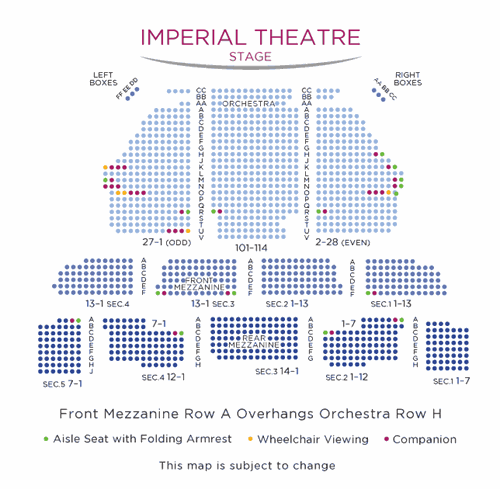








This fall, Tony Award® winner Aaron Tveit (Moulin Rouge!), Emmy® Award nominee Lea Michele (Funny Girl, Glee), and breakout powerhouse Nicholas Christopher (Sweeney Todd, Hamilton) star on Broadway in Chess - the iconic musical where power and passion collide, and the stakes couldn’t be higher.
It’s America versus Russia at the World Chess Championship, where the espionage and romance are as complicated and exhilarating as the game itself. For the two players and the woman torn between them, everything—personal, professional, and political—is at risk… and nobody’s rules are the same.
With a legendary score by ABBA’s Benny Andersson and Björn Ulvaeus, lyrics by Emmy, Grammy®, Oscar® and Tony winner Tim Rice (Evita, Jesus Christ Superstar), a new book by Emmy winner Danny Strong (Dopesick, The Butler), and direction by Tony winner Michael Mayer (Spring Awakening, Hedwig and the Angry Inch), Chess is the must-see Broadway event of the season.
Chess on Broadway Tickets
HISTORY
The Shuberts conceived of the Imperial Theatre, their fiftieth New York venue, as a home to musical theatre hits, and their dream has been realized many times over. The playhouse was constructed as a replacement for the Shubert’s 20 year old (and out-of-date) Lyric Theatre.
ARCHITECTURE
Like many other Shubert theatres, the Imperial was designed by Herbert Krapp in his trademark Adam-style. The recessed ceiling and ornamental panels that grace the walls are elaborately decorated with a number of motifs, including florals and geometrics. The rectangular auditorium is wider than it is deep, which allows most audience members to feel close to the stage and performers.
Spotlight on Broadway: Imperial Theatre from Spotlight on Broadway on Vimeo.
Access Information
Theatre is not completely wheelchair accessible. There are no steps into theatre from the sidewalk. Please be advised that where there are steps either into or within the theatre, we are unable to provide assistance.
Shubert Audience Services
The Imperial Theatre provides accommodations for patrons who are blind, deaf, partially sighted, and/or have hearing loss. The theatre provides infrared assistive listening devices for every performance at the theatre. In addition, beginning four weeks after a show’s official opening night performance, hand-held audio description devices, hand-held captioning devices, and unlimited access to downloadable audio description and/or captioning for personal mobile devices are all available free of charge. Prior thereto, we offer live-caption via CART using a hand-held device, upon request with two-weeks’ advance notice. For assistance, or If you have questions, contact Shubert Audience Services at 212-944-3700 or audienceservices@shubertorg.com. There is also a representative at the Shubert Audience Services kiosk at every performance to assist any patron with any of our devices, software, or technology. Hand-held devices are limited, although additional devices can be obtained with at least twenty-four hours’ notice.
Accessibility by Seating Section
Orchestra Location: Seating is accessible to all parts of the Orchestra without steps. There are no steps to the designated wheelchair seating location.
Mezzanine Location: Located on the 2nd level: up 2 flights of stairs (23 steps). Please Note: On the Mezzanine or Balcony level, there are approximately 2 steps up/down per row. Entrance to Front Mezzanine is behind row F.
Handrails: Available at the end of every stepped seat row in the Mezzanine.
Wheelchair | Companion Seat Locations:
Orchestra: U1 | U3, T1-3; O24 | O22. O18-20; K27 | K21-25; O23 | N23-27; O21 | O15-19
Aisle Seat with Folding Armrest | Companion Locations:
Orchestra: R101 | R102; R2 | R4; R1 | R3; H22 | H20; K26 | K24; L27 | L25
Elevators/Escalator
None Available
Restroom
There is a wheelchair accessible restroom (unisex) located on the main level.
Theatre Policies
The use of cameras, recording devices, cell phones, beepers, and other electronic devices during the performance is prohibited, except as permitted for accessibility services. Everyone attending a performance must have a ticket. Latecomers will be seated at the discretion of management. Wheelchair and mobility-impaired seating is intended for patrons with mobility disabilities. Children under the age of four years will not be admitted. No outside food or beverage permitted, unless medically necessary. No weapons permitted on the premises.
THEATRE SPECS
Imperial Theatre
249 West 45th Street
Between Broadway and 8th Avenue
New York NY 10036
| Year Built | 1923 | |
| Seating Capacity | ||
| Orchestra | 759 | |
| Front Mezzanine | 283 | |
| Rear Mezzanine | 377 | |
| Boxes | 20 | |
| Total | 1457 | |
| Included in Numbers Above: | ||
| Orchestra Pit | 18 | |
| Wheelchair | 5 | |
| Aisle Transfer Arm | 15 | |
| Theatre Dimensions | |
| Proscenium Opening: | 39' 7" |
| Height of Proscenium: | 25' 0" |
| Depth to proscenium: | 33' 8" |
| Depth to front of stage: | 40' 2" |
| Stage Type: | Proscenium |


















